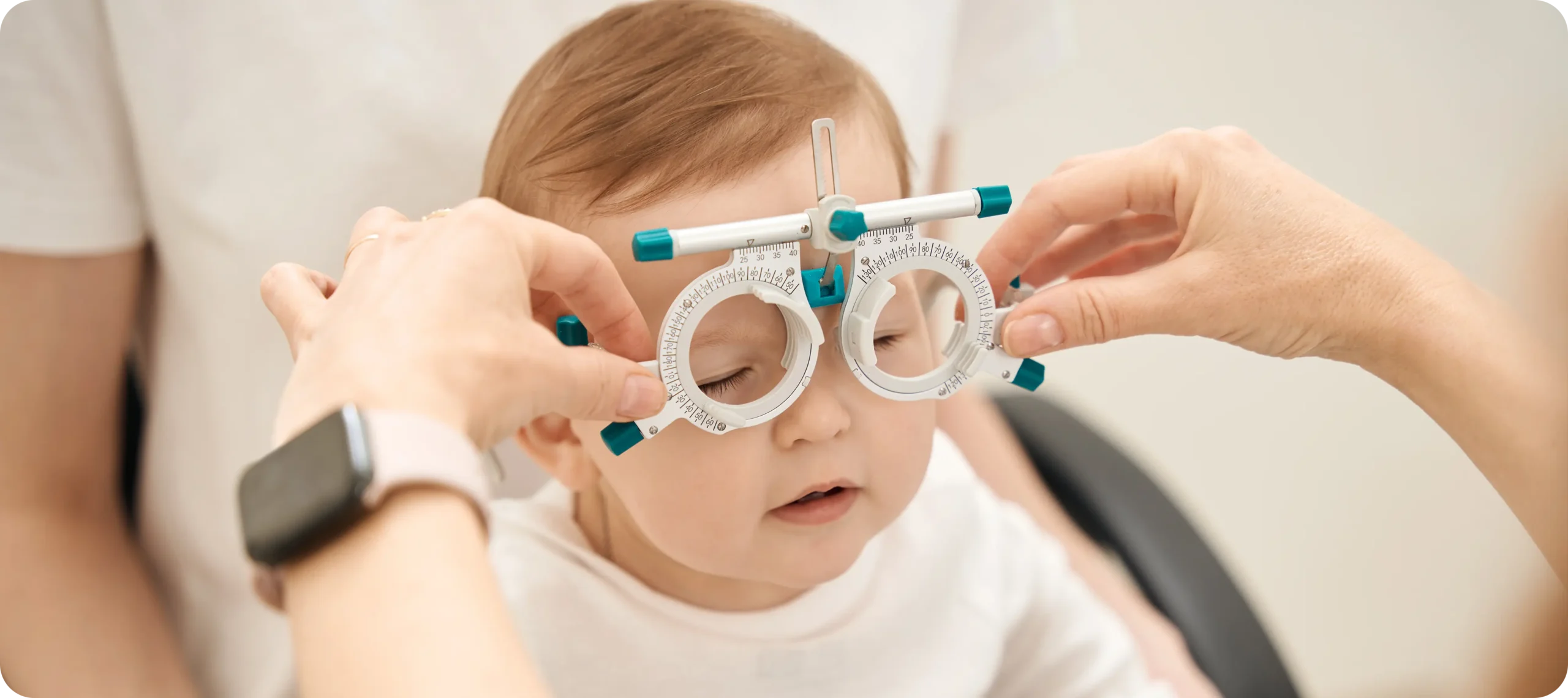Congenital cataracts refer to lens opacities that are present at birth or develop shortly thereafter. Unlike age-related cataracts, which typically occur due to degenerative changes later in life, congenital cataracts are often the result of genetic mutations, intrauterine infections, or metabolic disorders. Although they may vary in size, density, and location, even small cataracts can significantly impair visual development in infants and young children if not promptly detected and managed. Early diagnosis and timely intervention are crucial in preventing long-term visual deficits such as amblyopia.
These cataracts can affect one or both eyes, and their impact on vision largely depends on their severity and location within the lens. Some congenital cataracts remain stable and non-progressive, requiring minimal or no intervention, while others may rapidly worsen and demand urgent treatment. Because children are still in the critical stages of visual development, any barrier to clear visual input can have profound consequences on ocular growth and visual maturation. Consequently, congenital cataracts are regarded as a paediatric ocular emergency that warrants thorough investigation and multidisciplinary care.
Causes and Risk Factors
Genetic Mutations
A significant number of congenital cataracts are inherited, most commonly through an autosomal dominant pattern. This means that a child only needs to inherit one altered copy of the gene from either parent to be at risk of developing the condition. Often, there may be a strong family history of childhood lens opacities, although the exact presentation can vary from person to person, even within the same family. Genetic causes tend to result in bilateral cataracts, although unilateral cases are not unheard of. These inherited forms are typically non-syndromic, meaning they occur without other physical abnormalities.
Several genes involved in lens structure and maintenance have been linked to congenital cataracts. Among the most commonly implicated are CRYAA, CRYBB2, and GJA8. These genes produce proteins that are essential for maintaining the transparency and precise alignment of lens fibres. Mutations can cause these proteins to misfold, clump together, or fail to function properly, leading to clouding of the lens. In some instances, the mutations interfere with the lens’s ability to handle oxidative stress, further contributing to opacity formation.

Genetic testing is becoming increasingly important for identifying the underlying mutations in children with congenital cataracts. Pinpointing the specific genetic cause can not only help confirm the diagnosis but also guide counselling for families planning future pregnancies. It can also provide valuable insights into whether the cataracts are likely to progress or remain stable over time. This personalised information is essential for determining the best approach to long-term management and follow-up.
Intrauterine Infections
Infections contracted during pregnancy can have a profound effect on the developing foetus, especially during the early stages of organ formation. Certain pathogens have a known ability to cross the placental barrier and interfere with ocular development, often leading to congenital cataracts. Among the most significant are rubella, cytomegalovirus, toxoplasmosis, and herpes simplex virus. These infections can damage the lens either directly through inflammation or indirectly by disrupting the overall development of the eye and surrounding tissues.
The risk is particularly high when infections occur during the first trimester, which is a critical window for the formation of the lens and other eye structures. During this period, the embryonic lens is highly sensitive to any external insult. Even if the infection is mild or asymptomatic in the mother, the impact on the foetus can be severe. In some cases, these infections not only cause cataracts but are also associated with other ocular problems such as microphthalmia, retinitis, or optic nerve atrophy, depending on the specific pathogen involved.
Early detection of these infections during pregnancy through routine screening and serological tests can be instrumental in reducing the risk of ocular complications. Where possible, maternal immunisation (such as against rubella) before pregnancy plays a preventive role. In confirmed cases of intrauterine infection, early ophthalmological evaluation of the newborn becomes essential. The management of infection-related cataracts often involves both medical and surgical strategies, particularly if systemic symptoms or multiple organ systems are involved.
Maternal Rubella
Rubella infection during pregnancy remains a leading cause of congenital cataracts in parts of the world where vaccination coverage is low. The rubella virus, when acquired by a pregnant woman, can be transmitted to the developing foetus, particularly during the first trimester. The virus interferes with cellular replication and vascular development, which can severely affect the eyes, ears, heart, and brain. Cataracts caused by congenital rubella syndrome are typically bilateral and often form as part of a wider constellation of symptoms.
In the context of eye development, rubella infection is thought to interfere with the normal differentiation and maturation of lens fibres. This disruption leads to the early formation of dense lens opacities that can severely obstruct the visual axis. In many cases, the cataracts are already present at birth and may progress rapidly if not addressed. Infants with congenital rubella often exhibit other eye abnormalities such as pigmentary retinopathy and glaucoma, which further complicate treatment and prognosis.
The most effective way to prevent rubella-related cataracts is through widespread immunisation programmes targeting children and women of childbearing age. In countries with high vaccination rates, congenital rubella syndrome has become increasingly rare. However, in regions where access to vaccines is limited or misinformation discourages immunisation, rubella outbreaks continue to pose a risk. The importance of public health measures in preventing these avoidable causes of childhood blindness cannot be overstated.
Metabolic Disorders
Some congenital cataracts result from inherited metabolic disorders that affect the body’s ability to process certain substances. One well-known example is galactosaemia, a rare genetic condition in which the body is unable to break down galactose, a type of sugar found in milk. In affected infants, galactose and its byproducts accumulate in the bloodstream, including within the lens of the eye. This build-up alters the osmotic balance and protein structure of the lens, leading to rapid clouding shortly after birth.
Hypoglycaemia, or low blood sugar levels in neonates, is another condition that has been associated with cataract development, although the exact mechanisms are not fully understood. It is believed that glucose is essential for the proper functioning of lens cells, and sustained periods of low glucose availability may lead to lens fibre damage. Other metabolic issues, such as certain amino acid disorders or mitochondrial diseases, can also present with cataracts as one of their early signs.

Early recognition of metabolic disorders is vital, not only for addressing the cataracts but also for managing potentially life-threatening systemic effects. In many cases, dietary modifications or enzyme replacement therapies can reverse the cataracts or at least halt their progression if started promptly. Newborn screening programmes play a crucial role in identifying these conditions before irreversible damage occurs. A multidisciplinary team approach involving paediatricians, metabolic specialists, and ophthalmologists is often required to coordinate care effectively.
Clinical Presentation and Diagnosis
The presentation of congenital cataracts can vary significantly, depending on their size, density, and position. In severe bilateral cases, parents or caregivers may notice that the baby does not follow objects or fails to make eye contact, raising concern about impaired vision. In unilateral cases, the signs may be subtler and often go unnoticed unless detected during routine screening. The classic sign observed by healthcare professionals is a white pupillary reflex, or leukocoria, which can also be a feature of more serious conditions like retinoblastoma.
Diagnosis is typically made through a combination of clinical examination and specialised ophthalmic tests. A red reflex test using an ophthalmoscope is a vital part of the newborn screening process, ideally performed within the first few days of life. Any asymmetry, absence, or dullness in the red reflex warrants urgent referral to an ophthalmologist. Slit-lamp biomicroscopy, performed when the infant is old enough or under anaesthesia, allows for a more detailed assessment of the cataract’s morphology and extent.
Additional diagnostic tools may include ultrasonography of the eye, particularly when the cataract is dense and prevents fundus visualisation. In cases where a systemic cause is suspected, blood tests, metabolic screening, and imaging studies may be required. Genetic testing is increasingly employed to identify specific mutations, guide family counselling, and anticipate associated systemic anomalies.
Treatment and Management
The initial approach to treating congenital cataracts depends largely on the size, location, and impact of the cataract on the visual axis. Not all cataracts require immediate surgery; some minor, peripheral opacities may be monitored over time if they do not interfere with visual development. However, when cataracts obstruct the central visual pathway or progress rapidly, early surgical removal becomes essential to avoid long-term vision loss. Timing is critical—ideally within the first few weeks of life—particularly for dense bilateral cataracts or visually significant unilateral cases.
Surgery usually involves removing the cloudy lens material through a technique known as lens aspiration. In older infants and toddlers, this may be accompanied by implantation of an intraocular lens (IOL) during the same procedure, which helps restore focus. However, in very young infants, IOL implantation is often deferred due to concerns about ocular growth and long-term refractive shifts. In such cases, the eye is left aphakic, and visual correction is provided externally. The surgical procedure itself is delicate and performed under general anaesthesia, often involving a posterior capsulotomy and anterior vitrectomy to minimise the risk of secondary opacification.

Following successful removal of the cataract, the child enters a critical phase of care that determines their long-term visual potential. Surgery alone is not enough to restore sight—active post-operative management is vital to support proper visual development and prevent complications.
Post-operative Management
After surgery, children require a tailored visual rehabilitation plan to ensure the brain receives clear and focused images from both eyes. Without this, there’s a substantial risk of developing amblyopia, especially in unilateral cases. The goal is to provide a clear optical correction and stimulate consistent visual input during the sensitive period of neurovisual development.
- Contact lenses: For infants left without an intraocular lens, contact lenses are the primary method of vision correction. These are specially designed for paediatric use—soft, breathable, and safe for developing eyes. Parents or caregivers are taught how to manage the lenses at home, including insertion, removal, and cleaning. Though challenging at first, many families adapt well with proper guidance and support from the clinical team.
- Glasses: Spectacles may be used as an alternative or in combination with contact lenses, particularly in bilateral aphakia. Infant glasses are made with soft, flexible frames that wrap around the head for a secure fit. They are also used after secondary IOL implantation to fine-tune the child’s vision or correct any residual refractive error. While less precise than contact lenses in some cases, glasses can be a convenient option for long-term wear.
- Secondary IOL implantation: When IOL placement is delayed at the time of the initial surgery, a second operation may be planned for a later age—usually once the eye has grown more predictably. This approach allows better long-term visual correction with fewer complications related to eye growth. The timing of secondary implantation varies based on the individual child’s anatomy and response to earlier rehabilitation efforts.
- Occlusion therapy: In cases where only one eye is affected, patching the better-seeing eye is often necessary to encourage visual development in the weaker, operated eye. This helps prevent amblyopia and encourages the brain to build proper connections with the visual cortex. The intensity and duration of patching are carefully adjusted depending on how the child is progressing, with close monitoring during follow-up visits.
Regular follow-up is essential throughout the rehabilitation process. Children are monitored for complications such as inflammation, glaucoma, visual axis re-opacification, and refractive changes. The success of post-operative care depends heavily on close collaboration between ophthalmologists, optometrists, orthoptists, and the child’s family. Consistency with visual correction, patching, and appointments is key to giving the child the best possible chance at developing functional, long-term vision.
Prognosis and Long-Term Outlook
The visual prognosis for children with congenital cataracts largely depends on the timing of diagnosis, promptness of intervention, and consistency of post-operative care. Early treatment significantly improves the chances of developing useful vision, especially in bilateral cases where symmetrical input to both eyes can be restored. Unilateral cases are generally more challenging due to the heightened risk of amblyopia, but with aggressive therapy and vigilant follow-up, functional vision is often achievable.

Despite advances in surgical techniques and visual rehabilitation strategies, some children may still experience long-term visual limitations. These may include reduced visual acuity, impaired depth perception, or strabismus. Psychological and social factors can also influence the child’s development, particularly if visual impairment affects learning or mobility. Hence, early intervention programmes, inclusive education, and low vision support services are integral to holistic care.
Ongoing research continues to explore new genetic markers, improved surgical approaches, and innovative rehabilitation tools to further enhance outcomes. With growing awareness and advances in paediatric ophthalmology, the outlook for children born with congenital cataracts continues to improve, offering them the chance for a visually fulfilling life.
Summary
Congenital cataracts are a significant yet often overlooked cause of visual impairment in children, arising from diverse factors ranging from genetic mutations to prenatal infections. What sets them apart is their potential to disrupt the critical early stages of visual development, making early recognition and treatment absolutely vital. Though some cataracts may be mild and non-progressive, many pose a serious threat to visual clarity and require prompt surgical management. Understanding the broad range of causes—from inherited conditions to rare metabolic disorders—underscores the need for a multidisciplinary approach in both diagnosis and treatment.
Successful outcomes depend not only on the technical aspects of surgery but also on consistent aftercare and visual rehabilitation. Families play an essential role in the long-term management, particularly when it comes to post-operative therapy such as patching and optical correction. While advances in medical care have significantly improved the outlook for affected children, challenges remain in ensuring early detection, especially in underserved populations. As research continues to evolve, so too does the potential to refine both preventative strategies and long-term support, offering children with congenital cataracts the best possible start in life.

